Introduction to DCI STEM & littleBits
Kickoff your DCI STEM program! Students meet mentors and explore STEM invention tools.
SESSION ROLES:
🐙 = Site Coordinator
🦉= Mentor
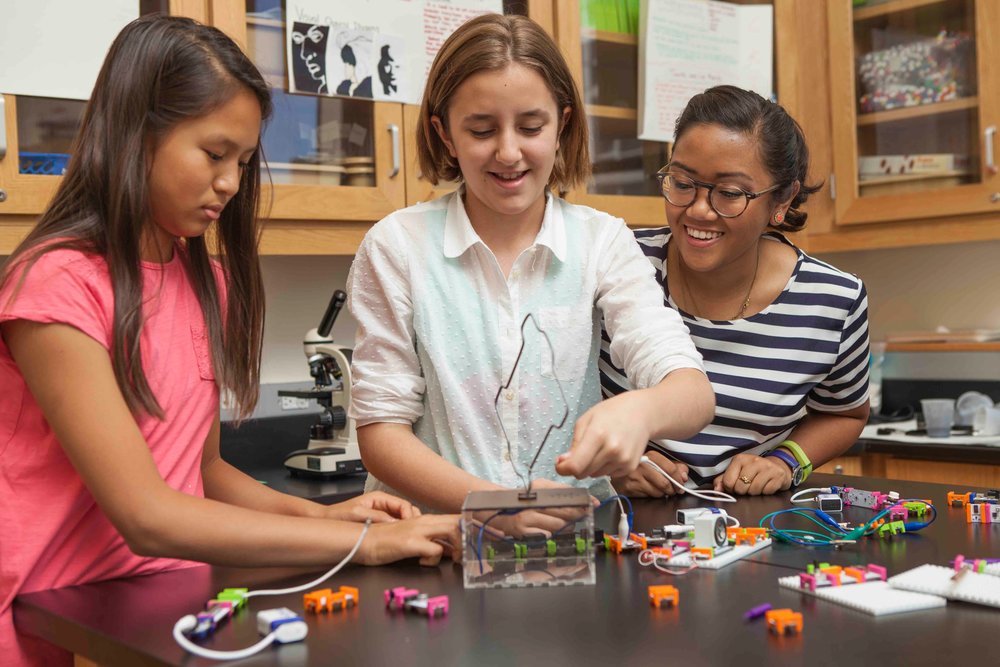
Note for Site Coordinators and Mentors
This guide provides a detailed outline for introducing students to DCI STEM and littleBits, but feel free to improvise or put your own spin to things. If you have an idea for a challenge or prompt that will get students excited, go for it! If something is not working well, change course and experiment another path forward. If you do change things up, we would love to hear what has been successful for you!
Session Overview
This session provides a fun and structured way to introduce DCI STEM. Students and mentors will get to know each other, and then learn about the STEM tools available to them; littleBits. littleBits kits are not provided by the DCI STEM program. They will start by exploring Bit Basics (e.g. color-coding, magnetic connections, the importance of order) and connect these concepts to basic science about the flow of energy through circuits. Once they’ve built their understanding of these core ideas, they will engage in short rounds of mini-challenges to explore simple input Bits, gain confidence, and spark their imagination.
Session Details
Difficulty:
Beginner
Duration:
2 hours
Subjects:
Engineering
Design
Science
Prerequisite Knowledge:
None (this session is designed as a first introduction to littleBits)
Supplies
Bits + Accessories:
littleBits STEM Inventor Kit
Device:
Mentors will need to bring a connected device (phone, tablet, or computer) to access instructional videos
Other Suggest Materials:
-
Sticker labels to mark individual students materials if not sharing a class set.
-
Markers, pens, or pencils
-
*Please have a few extra 9V batteries on hand
Description
Theme:
-
Introduction to DCI STEM
Objectives:
-
Students and mentors pair off
-
By the end of the session, students will be able to:
-
Build a complete series circuit while demonstrating knowledge of how the Bits connect via magnets;
-
Identify and understand the functional grouping of the color-coded Bits: powers, inputs, and outputs;
-
Describe how current changes in a series circuit when a component is added or removed;
-
Demonstrate knowledge of the directional flow of energy through a circuit;
-
Understand why the order of Bits is important to establish polarity; and,
-
Make connections between Bits and real-world applications.
-
Resources
Inspirational Links:
TED Talk: Building Blocks that Blink and Teach - Ayah Bdeir
littleBits Brings STEAM to Life
Helpful Links:
Set Up
🐙SITE COORDINATORS:
-
Make sure all the supplies for this session are prepped and ready to go.
-
Each student will need a littleBits kit.
-
-
Invite parents to stay for the introduction of the program if they like.
-
We suggest handing out the kits during the CREATE phase, after the introduction
-
Students will not be using the included paper templates in this session. We suggest they are kept in the box for next time.
🦉MENTORS:
-
Make sure to bring a charged connected device (phone, iPad, or computer) to access instructional videos during the session.
Check In & Pair Off
10 MIN
🐙SITE COORDINATORS
-
Check in students and mentor
-
Pair students with mentors
Get to Know Each Other
5 MIN
🦉MENTORS GET TO KNOW MENTEES
Take turns asking each other questions. Example prompts:
-
What do you like to do for fun?
-
What is your favorite subject in school? Why?
-
What is your favorite book or show? What do you like about it?
-
What type of music do you like to listen to?
-
What is the last thing you made that you are proud of? (could be a drawing, a story, a game with friends, a secret language, a dessert, a collage, etc..)
What is DCI STEM?
10 MIN
🐙SITE COORDINATORS INTRODUCE DCI STEM
Feel free to use this sample copy:
“Ask: Does anyone here know what STEM is?
STEM stands for science, technology, engineering and math. Unfortunately, there are fewer girls and women that show interest in these topics in school or pursue them as careers. This is too bad because girls can bring a very unique perspective to STEM and really make an impact on the future. You are the designers, creators, scientists, and technologists of tomorrow. You will have jobs that don’t even exist yet, and you will change the world! STEM is truly for everyone and we need more girls paving the path in these subjects. This is why we are so happy to have you participate in DCI STEM!
Ask: Can you think of any jobs in STEM?
Here are some examples:
-
Zoologists study animals
-
Electronics engineers design and build the world around us - a female engineer, Ayah Bdeir, built the littleBits kit you get as part of this program
-
Software developers create your favorite app and video games
This program is designed for you to explore all sorts of STEM topics, discover what interests you, and learn to bring your ideas to life though invention.
The program has 3 components:
-
Throughout the program, each of you will work with a mentor, either individually or in groups. The mentors are here to help answer any questions you may have and work with you during each session.
-
Each of you will be working with a littleBits STEM Inventor Kit. This kit is made up of electronic building blocks called littleBits that you will use to invent with during the program.
Program Overview
This program is made up of about (10) sessions. In each session we will be inventing with littleBits and discussing your STEM interests with your mentors. We want you to walk away with confidence and ideas for what interests you in STEM.
We have some really fun projects for you coming up. Today will be an introduction to littleBits. In upcoming sessions, you will also build electronic robot arms, smart home devices, Rube Goldberg machines, arcade games and more! The program will end with a showcase where we will invite your parents and caregivers to come see what you’ve made!
Let’s dive into learning about littleBits!
Introduce littleBits
10 MIN
🐙SITE COORDINATORS
-
Distribute Kits to students
-
Have students create a label for their kits with their name if applicable.
🐙SITE COORDINATORS INTRODUCE LITTLEBITS
You may want to show this one-minute “Welcome to littleBits” video to provide context and get the students excited:
Explain that littleBits are electronic building blocks that snap together to turn their ideas into inventions! Tell students that they will get to play with the Bits, learn how they work, and get to know the science behind electronics in our everyday lives.
Ask students to brainstorm ways in which we use and rely on electronics in our everyday lives. For example you might ask students to identify:
-
Toys that use batteries;
-
gaming systems that have to be plugged in;
-
appliances that cook our food or clean our clothes; or
-
lights that help them see at night.
Invite students to imagine and discuss the ways in which our lives would be significantly different without electronics. Make a connection by explaining that they are going to use littleBits to experiment and investigate with circuits to better understand how electronics work.
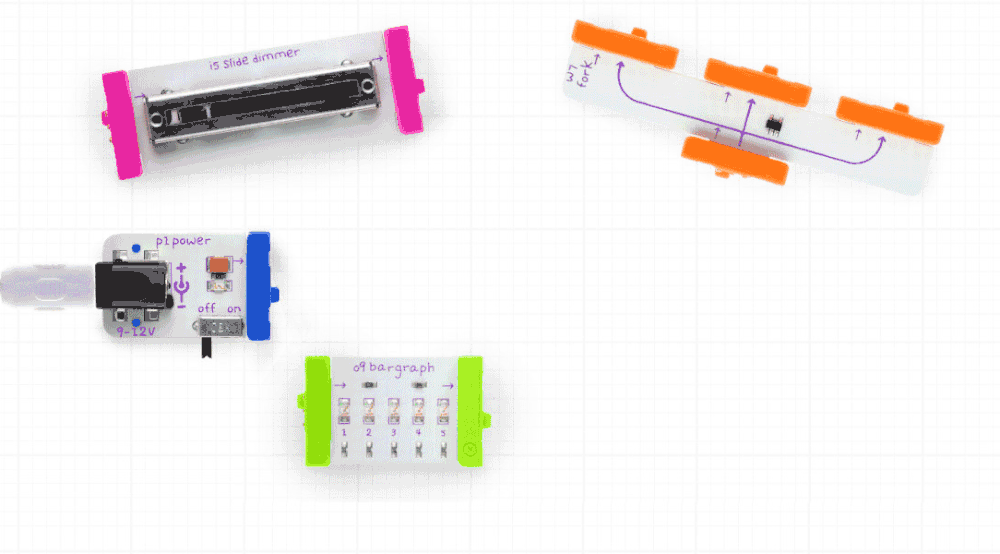
Inspire
10 MIN
🦉MENTORS REVIEW SESSION INSPIRATION VIDEOS AND PROMPTS
Career Exploration
As a warm up activity, mentors will explore two women in STEM who have made significant contributions to their field. Please take a few minutes to review the bios provided in the postcards below and brainstorm with your mentee what contributions they would make as a leader in this field fifteen years from now. Ask your mentee(s) the following:
- Can you see yourself in her job?
- Are you interested to learn more about her job?
- What inspires you about this role model?
(Expand on some phrases or words that may be difficult to understand.)
*The purpose of the postcards are meant to provide students with the career endeavors and examples of STEM positions of successful women in STEM to inspire them and explore different types of careers in STEM.*
Download Women in STEM postcards here:
LILLIAN GILBRETH AYAH BDEIR
Create
25 MIN
🐙SITE COORDINATORS:
-
During the hands-on activities, float around the room and observe/help out where needed.
-
You will also monitor the time and announce when the group should come together to share.
🦉MENTORS:
-
Facilitate the hands-on activities with mentees.
-
As you work through the session, make sure to review all Bit diagrams to learn how Bits work and how they relate to the real world. You can also find information about each Bit in the DCI STEM STEM Kit Bit Index. Students can use the Bit Index to spark their imagination for building with the Bits. These pages will be an important resource to learn and grow with littleBits.
-
Complete as many of the 9 mini-challenges as you can in the allotted time. It’s ok if you don’t do them all!
Explore the Bits
Open the kits. Encourage students to explore how the Bits connect. After a moment of exploration, ask to share what they have observed and learned about the Bits. For example, they might notice:
-
The Bits are color-coded/different colors;
-
they snap together; and,
-
there are magnets on the ends.
Watch Intro to littleBits Video Playlist
-
Inventing
-
Bit Basics
-
Bit Combinations
-
Bit Signals
-
Bit Components
Build a Series Circuit
Tell students that they’re ready to make a functioning circuit with the Bits.
Provide a few minutes to explore their Bits independently. Ask to build a circuit that will light the long LED. Identify the green Bits as outputs: these are the “doers” of the circuit.
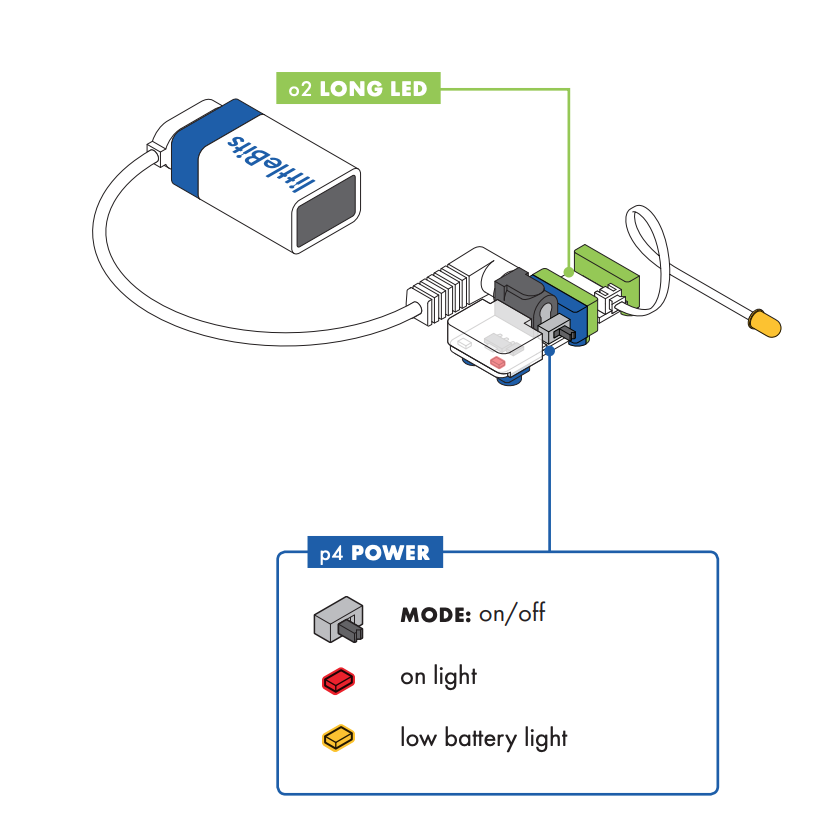
When each student/group has created a complete circuit, ask them to explain:
-
What role does the blue Bit play in the circuit, and how can you tell that it’s powered on?
-
Every circuit starts with power. It provides the electricity that makes your Bits spin, buzz, blink, and shine. When creating circuits, make sure you always have a blue power Bit that is connected to a battery.
-
-
What is the role of the green Bit? (The output; green Bits are the “doers” of the circuit)
-
Green Bits do things like light up, make sound, and create movement!
-
-
Does the order of assembly matter?
-
How do you know that the circuit is working?
-
How could you stop it from working? (They could disassemble the Bits to break the connection, disconnect the battery/cable from the power Bit, or turn off the switch on the power Bit)
Explain that what they just built is called a series circuit. A series circuit is a pathway through which energy can flow in one direction. The circuit has three basic components. Ask students to point to the:
-
power source (the battery)
-
conductive pathway (the battery cable and the blue power Bit)
-
output (the “doer” of the circuit that’s using the energy, in this case the RGB LED)
Review Power Bit and Long LED Bit Index Pages together and talk through the real world analogies:
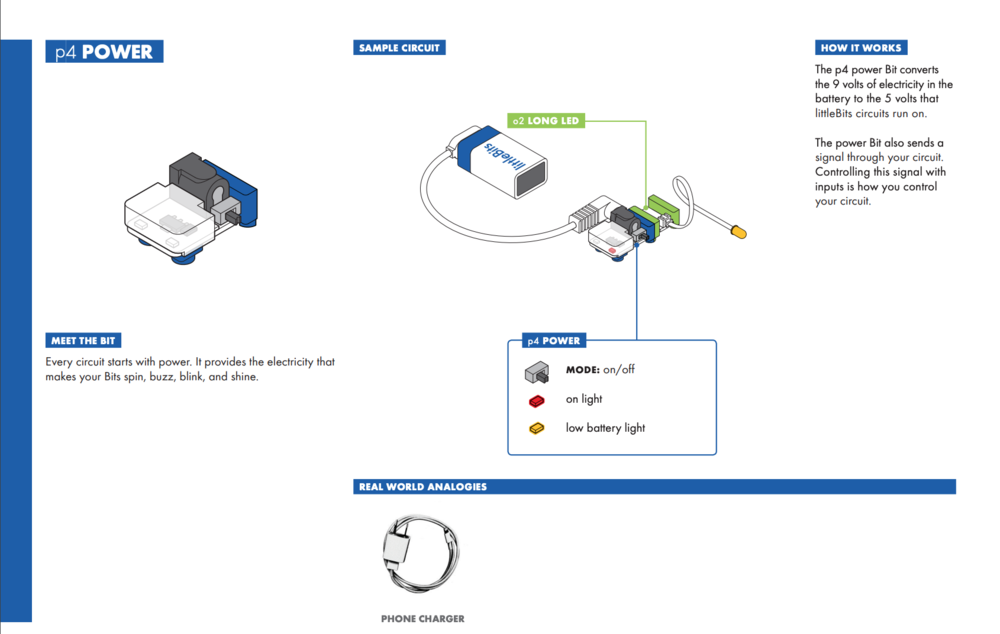
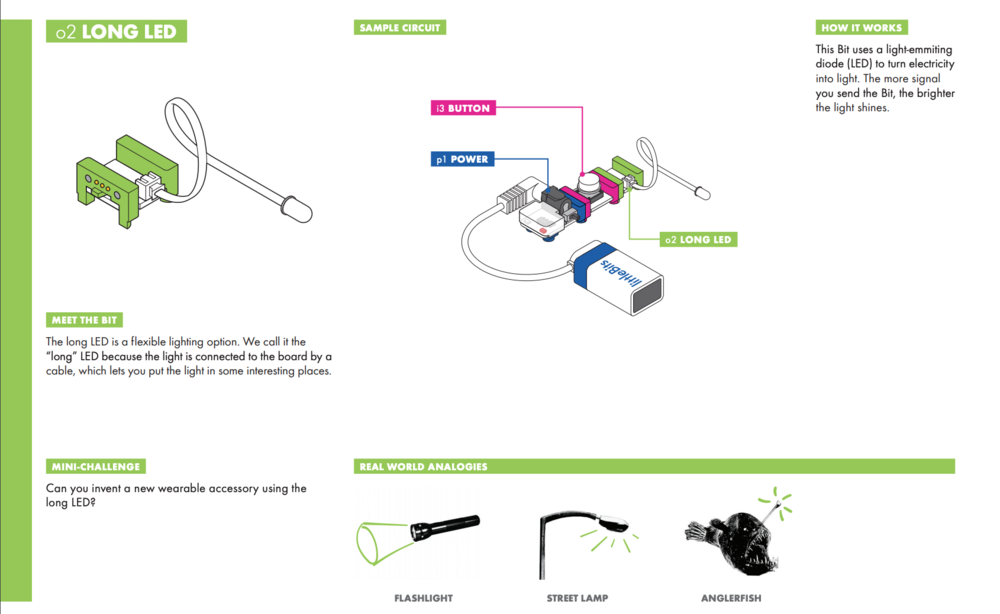
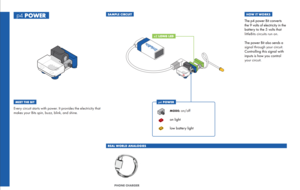
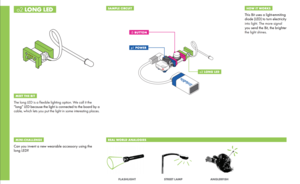
Make a Connection
When the parts of a circuit are connected correctly, this allows energy to flow from one Bit to the next. We see this energy as light on the long LED. When you remove one part or change the order of the Bits, you break the flow of energy. If the parts of a circuit are not connected correctly, then the energy doesn’t have a pathway and that’s when we see the light go out.

Magnets
Ask students to look closely at their circuit. Have them “flip” the direction of the output Bit (so either the Bit is upside down or the name of the Bit is upside down in front of them) and describe what happens (the magnets push back). Remind students that energy can only flow when the pathway is complete, and it can only flow in one direction—just like when they were holding hands in a circle. Prompt students to explain:
-
What happens when you flip the Bit? (You change the direction of the energy flow.)
-
Why do the magnets push back? (The poles no longer match and repel each other. This design by littleBits is meant to show us that our energy pathway is disrupted.)
-
How do you know that you are connecting Bits the right way?
MINI CHALLENGE #1
Announce that it’s time for their first invention challenge! Using the Bits they’ve learned about so far, challenge students to build a white reading light that you can use to secretly read books under the covers at night. How can you quickly turn it on and off so you don’t get caught?
-
Do the students connect the Bits correctly to create an energy pathway?
-
Can students name the basic components of their circuit?
-
Can they provide a simple solution for turning on and off the circuit?
Switch It Up
Ask students to connect the slide dimmer Bit between the blue power Bit and the green LED. Turn the power on and describe what happens.
Identify pink Bits as inputs: these are the controllers of the circuit. They control how the energy flows through the circuit pathway. Explain that this “dimmer” controls the flow of energy.
Give a few minutes to explore their new circuit. Ask them to explain:
-
What happens when you slide the dimmer?
-
What is happening to the flow of energy when you slide the dimmer?
-
What happens when you move the pink slide dimmer to a position after the green LED Bit?
-
What is the role of the pink Bit? (The input; these are the controllers of the circuit. They control how the energy flows through the circuit pathway.)
Review Slide Dimmer Bit Index Page
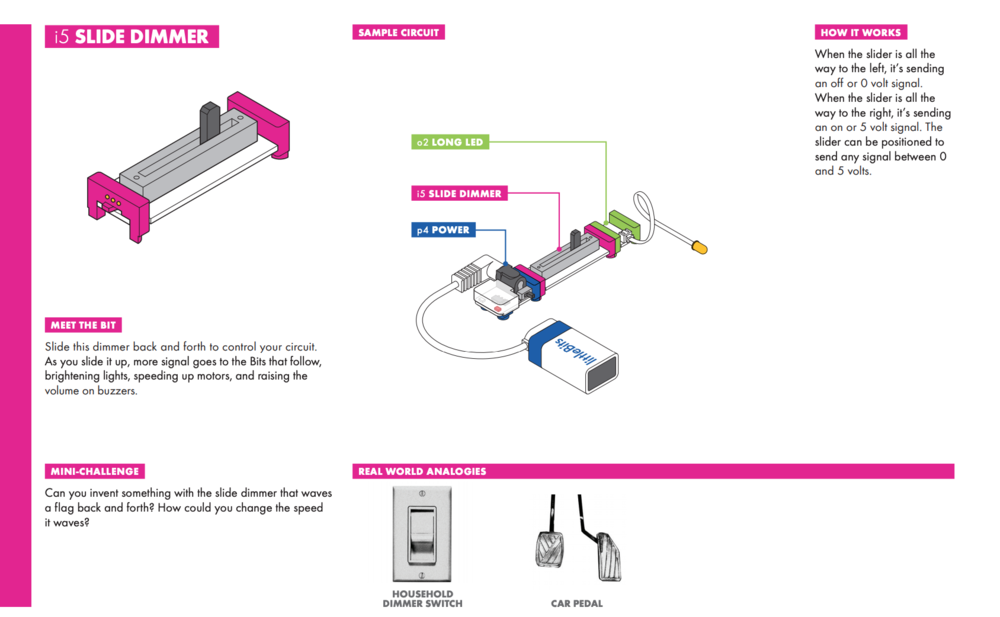
Provide rationale for why everyday electronics would require switches to control the flow of energy (light dimmers, acceleration pedal in a car, etc). Reinforce that when a circuit switch is “on” the energy is allowed to flow through the complete pathway.
MINI CHALLENGE #2
Improve your reading light circuit from Mini-Challenge 1. How could you change the brightness and use it as a dim nightlight when it’s time to go to sleep?
Hint: Use the slide dimmer to control the brightness of the LED.
-
Do students correctly identify and connect the slide dimmer Bit?
-
Do they arrange the Bits in the correct order?
-
Can students explain why they connected the Bits in that order?
-
Can students explain the function of the input Bit in controlling the flow of energy through the circuit?
As students wrap up the challenge, explain that they will continue to build on their inventions by adding additional Bits into the mix!

MINI CHALLENGE #3
Let’s change it up! How could you remix your circuit to create a fire engine siren that makes a noise and lights up?
Hint: Think about how each input Bit controls the flow of energy. Which input would work best for a siren?
-
Do students remix their circuit with the slide dimmer and buzzer Bits?
-
Can they explain why the order of the Bits is important?
Review Buzzer Bit Index Page:
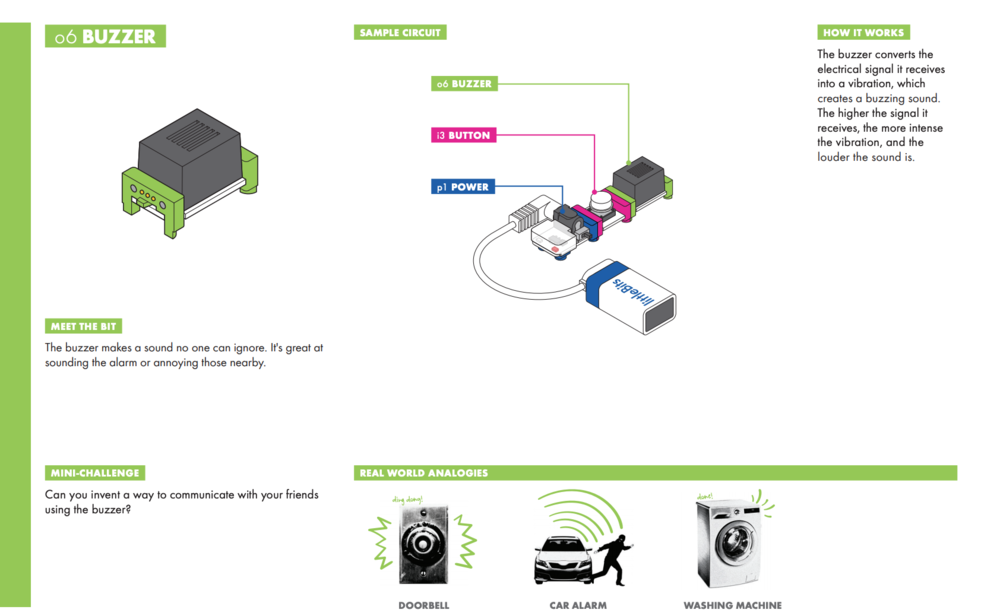
Motion & Modes
15 MIN
Review Servo Bit Index Page:

MINI CHALLENGE #4
Using the Bits they’ve learned about so far, challenge students to build a musical metronome that can play a beat to help a musician keep time.
If they are unfamiliar, explain that a metronome is a mechanical or electrical instrument that makes repeated clicking sounds at an adjustable pace. This video provides an example: https://bit.ly/2UDICSG.
Hint: Make sure the servo is in SWING mode. Attach the mechanical arm and use the servo mount to press the servo into a mounting board. Place an object (for example, a water bottle or glass mug) in the pathway of the servo that plays a noise each time the arm strikes it.
-
Is the circuit assembled in a way that it keeps a steady beat?
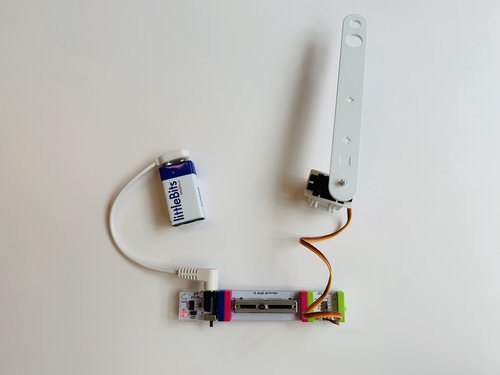
Attach mechanical are to Servo Bit

Make sure Servo Bit is set to SWING mode (flip the tiny black switch)
MINI CHALLENGE #5
Improve your musical metronome circuit from Mini-Challenge 4. How could you change the beat to be faster or slower to keep time with your favorite song?
Invite students to play music or sing along to the beat.
Hint: Use the slide dimmer to control the speed of the swing. What happens when you switch the servo to TURN mode?
-
Do they correctly identify and connect the slide dimmer Bit?
-
Do students switch the servo to SWING mode?
-
Do they arrange the Bits in the correct order?
-
Can they explain why they connected the Bits in that order?
-
Can students explain the function of the input Bit in controlling the flow of energy through the circuit?
MINI CHALLENGE #6
Let’s change it up! Can you invent something with the servo to help clean your desk?
Note that there are many ways to approach this challenge using any of the Bits and accessories in their kit.
-
Do students use multiple input and output Bits on the same circuit?
-
Can they explain why the order of the Bits is important?
Sensors & Logic
10 MIN
Review Proximity Sensor Bit Index Page:
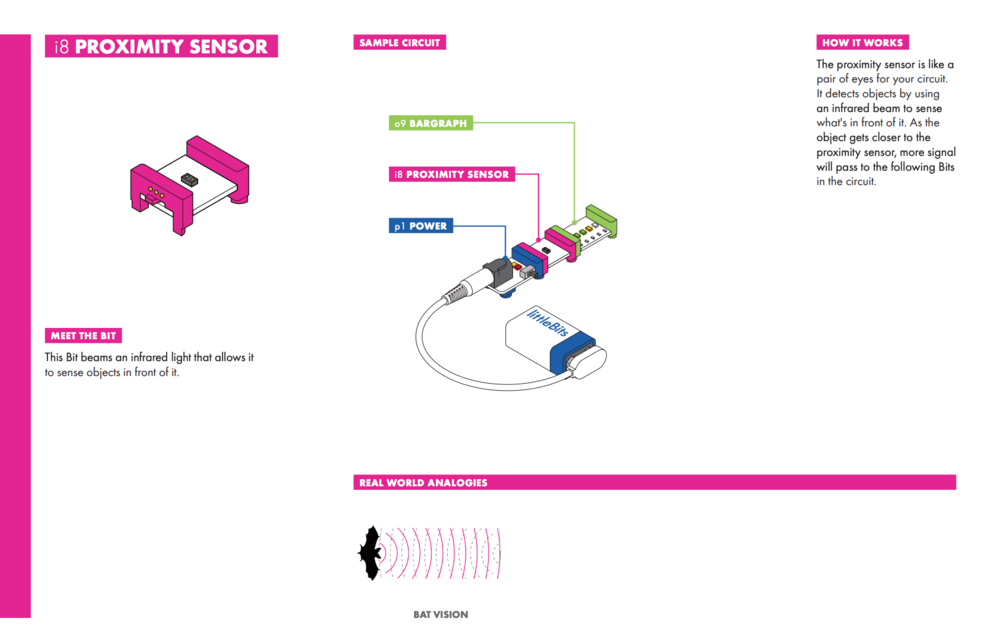
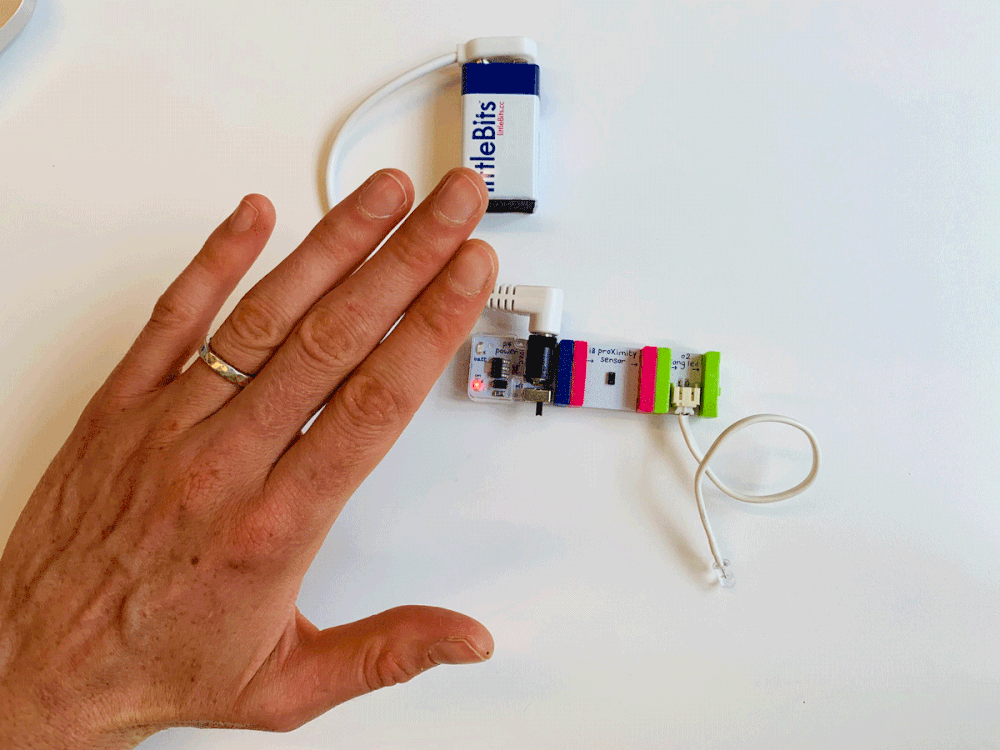
MINI CHALLENGE #7
Tell students to imagine that we’re an electronics company that is tasked with building the technology for a smart house. Our client has several ideas that they’d like us to prototype. Using the Bits they’ve learned about so far, Challenge them to create an intruder alarm that sounds when someone is close by.
Review Sound Trigger Bit Index Page:

MINI CHALLENGE #8
The client also wants a lighting system that turns on someone makes noise.
Review Latch Bit Index Page:
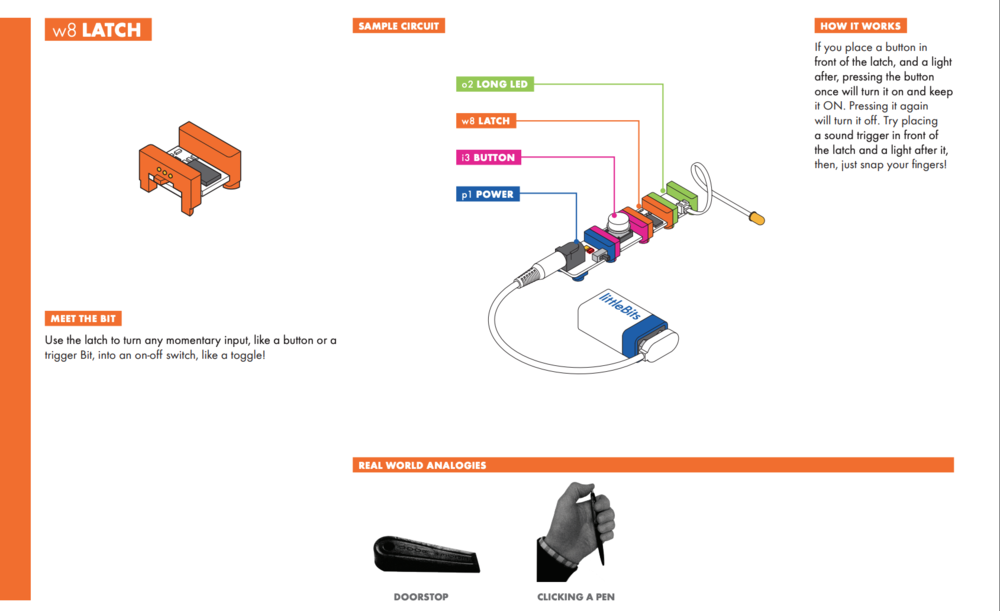
MINI CHALLENGE #9
Now, the client wants a little more control over the lighting system. Challenge them to Modify your automatic light to stay on or stay off.

Reflect/Share
5 MIN
🐙SITE COORDINATORS
Wrap up the session by reviewing what we have learned about how Bits work.
-
Have students say a “Today I learned…” statement
-
Conclude the discussion by asking how the circuits they made compare to circuits they’ve seen in the real world.
Give a preview of the next session:
-
Next week, we will learn about the littleBits Invention Cycle and build inventions that move!
Close
5 MIN
🦉MENTORS
-
Make sure students power off the Power Bit and disconnect the battery
-
Make sure all the parts shown on the side of the box are accounted for and put them away in the kit.
Get Social!
📷 We love to see invention in action! Take photos/videos of your session and tag us on social with the hashtag #snapthegap. *Please make sure you have sharing authorization from parents and your affiliated organization before posting.


